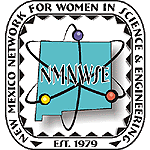 |
Northern Chapter of the New Mexico Network for Women in Science and Engineering LUNCHTIME TALK SERIES https://archive.nmnwse.org/lawis/lunchtalks Talk at 12:00, Wednesday, December 7, 2005 Bradbury Science Museum Auditorium 15th and Central, Los Alamos |

|
|
Claudia Lewis, EES-9, LANL
Dilational Normal Faulting on the Pajarito Plateau, Rio Grande Rift, New Mexico |
The surface expression of the tectonically active Pajarito fault system (PFS) ranges from simple normal faulting to complex zones of distributed faulting and monoclinal folding. The Pleistocene (1.22 Myr old) Tshirege Member of the Bandelier Tuff (Qbt) provides an exceptional datum for studies of the PFS's Quaternary evolution. As the fault system cuts Qbt nearly end to end along its 50 km length, we use it to construct a composite fault displacement profile. Throw measured on displaced contacts of Qbt subunits or on the displaced top of the tuff shows that the PFS consists of numerous sections (8-12 km long) that each exhibit their maximum throw near their midpoint with throw dying out toward their ends. The cumulative displacement profile describes an elliptical shape typical of an isolated fault although the profile is somewhat saw-toothed with prominent throw deficits at locations where the main Pajarito fault bends sharply. The style of deformation is particularly complex at these bends. Where slip is transferred from the N-striking Pajarito fault (PF) to the NE-striking Santa Clara Canyon fault (SCC), the PF forms a classic fault tip, where deformation is distributed across a broad zone of en echelon, small-displacement, synthetic and antithetic normal faults, fissures, and monoclinal folds. Short fault lengths and changes in sense of throw along strike are common. Two prominent antithetic faults relay slip to the SCC beyond the tip of the PF. Their maximum throw is greatest on the end closest to the PF, indicating fault interaction. Faults with opposing dips in the bend likely interlock, posing a geometrical barrier where ruptures either nucleate or terminate. That this portion of the PFS is strong fits with the slip deficit at this location and the paleoseismic event chronology, which demonstrates that the antithetic faults do not rupture every time the PF does. This bend in the fault system is also characterized by dilational normal faulting. Open, surficial fissures are common as are sediment-filled fissures, open framework breccias, and considerable fault plane topography in trench exposures of fault splays. These features are consistent with substantial dilation in the fault bend. This style of deformation enhances fluid flow and transport and must be factored into hydrogeologic investigations. (LA-UR-05-5275)
Biography - Claudia Lewis works on seismic hazards in the vicinity of LANL, fracture systems and fluid flow, and various projects in Spain. In addition to her scientific work, she was the founding President of the Board of the Pajarito Environmental Education Center in Los Alamos, which serves as a resource for the interpretation and stewardship of the natural history and environment of Los Alamos County and the Jemez Mountains area.
 | Members and Nonmembers Welcome - Open to the Public |  |